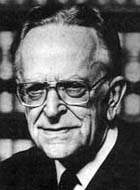|
The
Court in
recent decades has looked to the Tenth Amendment
as a basis for
building
"the
new federalism." At other times, the Court
seems to have viewed
the Amendment as little more than a truism.
The meaning of the
Tenth Amendment remains controversial both within
the Court and among
politicians, some of whom see it as the most
important of all the first
ten amendments. Tenth
Amendment
In 1976, in National League of Cities v Usery, the Court struck down provisions of a federal law that extended minimum wage protection to almost all state and municipal employees. Although the Court recognized that the Commerce Clause authorized minimum wage laws covering most employees, the Court held that the Constitution's structure and the Tenth Amendment's recognition of the role of states in the federal structure prohibited the federal government from telling states what they must pay their own employees. Nine years later, however, the Court overruled National League of Cities in Garcia v San Antonio Metro Transit Authority when Justice Blackmun--who had provided the critical fifth vote in the earlier case--reversed himself, concluding that the National League of Cities rule was causing so much confusion in the lower courts as to be "unworkable."
The federalism debate again resurfaced in the 1992 case of New York v United States, when the Court invalidated a provision of the Radioactive Waste Policy Act that required states failing to develop an adequate plan for disposing of waste generated within their own borders to, "at the request of the owner or generator of the waste, take title to the waste." The Court found that the so-called "take title" provision effectively "commandered the legislative processes" of states--something that the federal government cannot constitutionally do. In Printz
v
United
States (1997), the Court again found that
Congress had
unconstitutionally
intruded upon state sovereignty. The law in
question in Printz
was a provision of the Brady Act requiring chief
law enforcement
officers
of states to run background checks on prospective
hand gun
purchasers.
The Court rejected the federal government's
argument that it could
coercively enlist
states in enforcing federal law, even though it
might be
unconstitutional
to require states to make law--the problem
identified in New York v
U. S. The
Court, in
both New York
and Printz,
was not crystal clear about
the basis for its decisions. The cases could
be seen either as
resting on the 10th Amendment itself or be read as
concluding that the
10th Amendment limited what might otherwise have
been actions within
the Commerce Clause power. More likely
still, the cases should be
viewed as concluding that the federal actions
amounted to violations of
federalism principles implicit in the structure of
the Constitution
(including, of course, the 10th Amendment). The
Tenth Amendment was cited for support by the Court
in its 2013 decision invalidating a key portion of
the Voting Rights Act, Shelby County v Holder.
In its 5 to 4 decision invalidating the Act's
coverage formula, which required a group of mostly
southern states to seek preclearance from the
federal government for changes in their voting
laws, the Court noted that the Tenth Amendment was
intended to give states "broad autonomy in
pursuing legislative objectives." Mostly,
however, the decision rested on the principle that
states under our Constitution enjoy "equal
sovereignty." The Court used the phrase
repeatedly, including in the first paragraph of
the opinion, and stressed that equal sovereignty
was a "historic tradition" and "essential to the
scheme upon which the Republic was
organized." The takeaway from the case is
that differential treatment of the states by the
federal government, at least with respect to
matters relating to its ability to pursue its
legislative objectives, will be subject to
heightened judicial scrutiny--burdens will have to
be justified by a substantial federal interest and
there must be a substantial link between the
states singled out for less favorable treatment
and the problem addressed. If, for example,
the Congress were to use its Commerce Clause power
to require 15 states to have their laws imposing
taxes on Internet sales to residents be precleared
by the Commerce Department, but left the other 35
free to enact such legislation without federal
approval, such a law would almost certainly be
struck down under Shelby's "equal
sovereignty principle."
|
Cases
2. Similarly, the judges who urged respect for the doctrine of stare decisis in Garcia v San Antonio Metro Transit Authority were, for the most part, those judges who ridiculed reliance on stare decisis (with respect to Roe v Wade) in the abortion case of Casey v Planned Parenthood. Does this suggest that judges should be more open about the real reason for their decisions, which often seem to be a concern about consequences? 3. What is the basis for the Court's holdings in New York v United States and Printz v United States? Is it that Congress acted outside of its Commerce Clause power, that the laws in question violated the Tenth Amendment, or that the laws in question are inconsistent with the federal system implicitly envisioned in the Constitution? 4. Do you agree with the majority in Garcia that the National League of Cities rule had shown itself to be "unworkable"? 5. If a law really does violate the Constitution, is it reason enough to allow the law to be enforced because the Court cannot imagine a "workable" rule that could be applied to decide the constitutionality of other laws raising similar issues? 6. Is Justice Blackmun right in Garcia in his suggestion that states are adequately protected by the Constitution's structural provisions and need no additional protection from the judiciary? 7. Is there any other area of constitutional law that so clearly splits the Court along ideological lines than these cases raising "states' rights" issues? 8. Apart from issues of constitutional law, how should power be divided between the national and state governments? The federal government is often criticized, but it was the federal government that ended slavery, brought the country out of the great Depression, ended the reign of the Third Reich, and ended racial segregation? What great things have been accomplished through state governments? What areas of regulation (education, pollution control, law enforcement, etc.) have been better administered at the state level than at the federal level? 9. The states are often seen as "laboratories" for social experiments. What are some examples of successful experiments that have been carried from one state to the several states? What are some examples of experiments that are now ongoing in a single state or small number of states? 10. Where in the Constitution does Shelby's "equal sovereignty principle" come from? What types of distinctions with respect to the states can the federal government make after Shelby? How extensive of a record must the federal government develop before it can impose significant burdens on some states but not others? |


